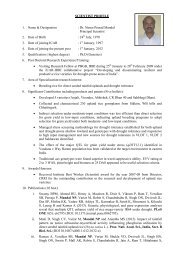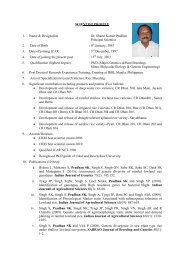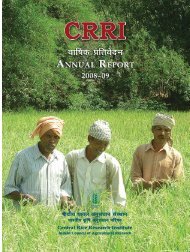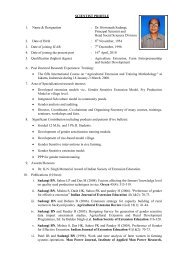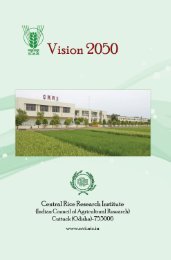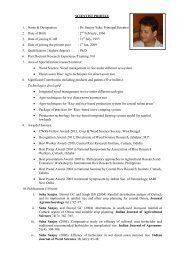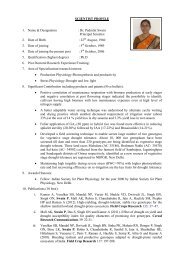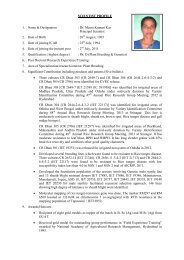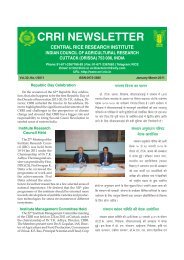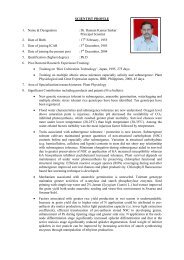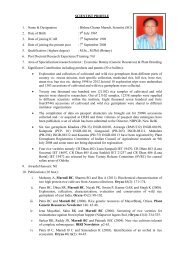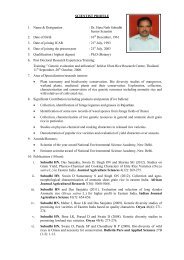Central Rice Research Institute Annual report...2011-12
Central Rice Research Institute Annual report...2011-12
Central Rice Research Institute Annual report...2011-12
You also want an ePaper? Increase the reach of your titles
YUMPU automatically turns print PDFs into web optimized ePapers that Google loves.
Natural Resource Management<br />
and Input Use Efficiency for<br />
Improved Crop Production<br />
Enhancement of the Resource Use<br />
Efficiency<br />
Development of management strategies for<br />
sustainable crop and soil productivity in<br />
irrigated and favourable rainfed lowland<br />
ecosystems<br />
A field experiment was conducted during 2011 with<br />
the objective to develop improve N management practice<br />
for enhancing N use efficiency under irrigated<br />
condition.Three improved methods of N management,<br />
viz., LCC based, USG based and Sabant’s Improved <strong>Rice</strong><br />
Agro-technology (SIRA) were compared with recommended<br />
practice of N management (N:P:K: @<strong>12</strong>0:60:60<br />
kg ha -1 ) along with controls (no N, no NPK ) using the<br />
variety ‘Swarna’. Nitrogen was applied @ <strong>12</strong>0 kg ha -1 in<br />
USG based and SIRA treatments, where as 90 kg<br />
ha -1 was applied in LCC based management, in these<br />
three treatments P and K was applied at recommended<br />
dose of 60 kg ha -1 . Among all the three methods of N<br />
management, no significant difference in grain yield<br />
was observed; however, NUE was highest in LCC based<br />
N management (41.1 kg grain -1 kg N) followed by SIRA<br />
(29.58 kg grain kg -1 N).<br />
In another experiment, feasibility of zero tillage visà-vis<br />
incorporation of residuary organic matter of pre-<br />
ceding legume crop was studied under rainfed lowland<br />
rice system. The treatments included tillage practices<br />
(conventional tillage and zero tillage), residue incorporation<br />
(no residues and with residues) and two<br />
doses of NPK (100% RFD and 50% of RFD) which were<br />
replicated thrice in split-split plot design. Application<br />
of 50% NPK along with crop residues resulted higher<br />
yield over 100% NPK treated plots.<br />
Simulation approach for optimization of<br />
nutrient use<br />
A field experiment was conducted with mediumlong<br />
duration rice varieties viz., Pooja and Pratiksha in<br />
wet season during 2011 under varying nitrogen dose<br />
and application schedule. The result revealed that<br />
across the treatments, the mean leaf area index (LAI) of<br />
Pooja ranged from 2.8 at active tillering (AT) stage to<br />
4.5 at flowering stage. Effect of treatment on LAI was<br />
non-significant. Across the treatments and variety the<br />
cumulative N uptake upto AT stage ranged from 15.1-<br />
22.7 kg ha -1 which is about 20-40% of total uptake; 53-<br />
70% of total uptake took place between AT and flowering<br />
stage. Among all the treatment combinations, yield,<br />
AE N<br />
and RE N<br />
ranged from 3.2-4.8 t ha -1 , 6.7-16.7 kg kg -1 ,<br />
and 30.5-40.7%, respectively (Table 25). Reduction of<br />
basal dose of N from 50 to 33% enhanced both N use<br />
efficiency and yield.<br />
Table 25. Effect of N application strategy on Yield, AE N<br />
and RE N<br />
Yield (t ha -1 ) AE N<br />
(kg kg -1 ) RE N<br />
(%)<br />
Treatments Pooja Pratiksha Mean Pooja Pratiksha Mean Pooja Pratiksha Mean<br />
T1 3.3 3.2 3.2 - - - -<br />
T2 3.9 4.0 4.0 6.7 9.0 7.8 32.5 32.3 32.4<br />
T3 4.3 4.2 4.3 11.1 11.2 11.2 40.7 38.4 39.6<br />
T4 4.8 4.6 4.7 16.7 14.6 15.6 32.6 30.5 31.6<br />
Mean 4.0 4.0 4.0 11.5 11.6 11.5 35.3 33.7 34.5<br />
C.D.(5%)Variety (V) 0.24 3.5 5.6<br />
Treatment(T) 0.45 5.3 7.4<br />
VXT 0.7 7.5 14.6<br />
T1: N 0; T2: N 90 kg ha -1 (50%. 25% and 25% at transplanting, maximum tillering (MT) and panicle initiation (PI);<br />
T3: N 90 kg ha -1 (33%, 33% and 33% at 15 days after transplanting, MT and PI); T4: <strong>12</strong>0 kg ha -1 (50%, 25% and 25%<br />
at transplanting, MT and PI)<br />
60 CRRI ANNUAL REPORT 2011-<strong>12</strong>



